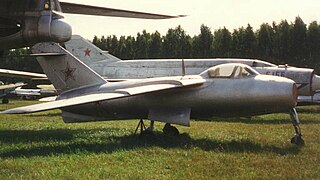
Artem (Artyom) Ivanovich Mikoyan was a Soviet Armenian aircraft designer, who cofounded the Mikoyan-Gurevich design bureau along with Mikhail Gurevich.

The Mikoyan-Gurevich MiG-9 was the first turbojet fighter developed by Mikoyan-Gurevich in the years immediately after World War II. It used reverse-engineered German BMW 003 engines. Categorized as a first-generation jet fighter, it suffered from persistent problems with engine flameouts when firing its guns at high altitudes due to gun gas ingestion. A number of different armament configurations were tested, but none solved the problem. Several different engines were evaluated, but none were flown, as the prototype of the MiG-15 promised superior performance.

The Mikoyan-Gurevich I-250, aka MiG-13, was a Soviet fighter aircraft developed as part of a crash program in 1944 to develop a high-performance fighter to counter German turbojet-powered aircraft such as the Messerschmitt Me 262. The Mikoyan-Gurevich design bureau decided to focus on a design that used something more mature than the jet engine, which was still at an experimental stage in the Soviet Union, and chose a mixed-power solution with the VRDK motorjet powered by the Klimov VK-107 V12 engine. While quite successful when it worked, with a maximum speed of 820 km/h (510 mph) being reached during trials, production problems with the VRDK fatally delayed the program and it was canceled in 1948 as obsolete.

The Lavochkin La-15, was an early Soviet jet fighter and a contemporary of the Mikoyan-Gurevich MiG-15 which was in service with the Soviet Air Force from 1949 till 1953.

The Yakovlev Yak-23 is an early Soviet jet fighter with a straight wing. It was developed from the Yak-17 in the late 1940s and used a reverse-engineered copy of a British engine. It was not built in large numbers as it was inferior in performance to the swept-wing Mikoyan-Gurevich MiG-15. Many Yak-23s were exported to the Warsaw Pact nations and remained in service for most of the 1950s, although some were still in use a decade later.

The Yakovlev Yak-1 was a Soviet fighter aircraft of World War II. The Yak-1 was a single-seat monoplane with a composite structure and wooden wings; production began in early 1940.

The Yakovlev Yak-15 is a first-generation Soviet turbojet fighter developed by the Yakovlev design bureau (OKB) immediately after World War II. The main fuselage was that of Yakovlev Yak-3 piston-engine fighter modified to mount a reverse-engineered German Junkers Jumo 004 engine. The Yak-15 and the Swedish Saab 21R were the only two jets to be successfully converted from piston-power to enter production. 280 aircraft were built in 1947. Although nominally a fighter, it was mainly used to qualify piston-engine-experienced pilots to fly jets.

The Yakovlev Yak-25 was a Soviet military aircraft, an early turbojet-powered fighter aircraft designed by the Yakovlev OKB. The designation was later reused for a different interceptor design. Tasked by the Council of Ministers in a directive issued on 11 March 1947, with producing a straight winged fighter similar to the earlier Yak-19, but powered by a Rolls-Royce Derwent V, OKB-115 swiftly produced the Yak-25, which blazed several trails as the first Soviet fighter with a fully pressurised cockpit, air conditioning, jettisonable canopy, and hydraulic airbrakes on the fuselage amongst other innovations.

The Klimov RD-500 was an unlicensed Soviet copy of the Rolls-Royce Derwent V turbojet that was sold to the Soviet Union in 1947. The Klimov OKB adapted it for Soviet production methods and materials.

The Klimov VK-107 was a V-12 liquid-cooled piston aircraft engine used by Soviet aircraft during World War II.

The Yakovlev Yak-30 was an experimental Soviet interceptor from the late 1940s. Derived from the Yak-25, from which it differed primarily in having wings sweptback 35° at quarter chord, the Yak-30 retained the fuselage, tail surfaces and undercarriage of the earlier fighter.
The Sukhoi Su-5 or I-107 was a Soviet mixed-power prototype fighter aircraft built toward the end of World War II.

The Sukhoi Su-15 was a prototype Soviet all-weather interceptor which never reached production.

The Lavochkin La-200 was a two-seater, swept winged, night/all-weather jet prototype designed as an interceptor and manufactured by the Soviet Union's Lavochkin Design Bureau from 1948.

The Yakovlev Yak-1000 was a Soviet supersonic technology demonstrator intended to evaluate the aerodynamic layout and field performance of the cropped delta wing discussed in captured German documents in combination with the new Lyulka AL-5 turbojet. The tandem undercarriage proved to be unsatisfactory and there were serious flight stability problems related to the delta wing, enough so that it never flew after an accident during taxiing tests.

The Yakovlev Yak-140 was a Soviet prototype lightweight supersonic fighter developed during the 1950s. The prototype was completed in 1954, but it was denied authorization to enter flight testing and the program was cancelled in 1956.
The Mikoyan-Gurevich I-75 was the final design of a series of three experimental swept-wing interceptors developed in the Soviet Union in the mid-late 1950s by the Mikoyan-Gurevich design bureau from their Mikoyan-Gurevich I-3 airframe. All the aircraft in the I-3 program were affected by delays in the development of the Klimov VK-3 turbojet engine, its cancellation and ultimate replacement by the Lyulka AL-7F turbojet engine.
The Mikoyan-Gurevich I-3 was the first of three interrelated fighter prototype programs developed by the Mikoyan-Gurevich design bureau in the Soviet Union in the mid/late 1950s – starting with the I-3, continuing with the I-7 and finally evolving into the I-75. On several occasions airframes were rebuilt and/or reused, both within a program or in a succeeding program. All the aircraft in the I-3 program were affected by delays in the development of the Klimov VK-3 afterburning bypass turbojet engine, and its cancellation and replacement by the Lyulka AL-7F turbojet engine.

The Mikoyan-Gurevich I-320 was a prototype Soviet long-range all-weather interceptor aircraft of the late 1940s-early 1950s. Only two were made, with no production following.
The Mikoyan-Gurevich I-350, was a Soviet Cold War-era experimental fighter aircraft. It was the first Soviet aircraft able to maintain supersonic speed.
















